For our tour description, itinerary,
past triplists, dates, fees, and more, please VISIT OUR TOUR PAGE.
See this triplist in printable PDF format with media only on
page 1.

A common
hummingbird of Ecuador's southwest, the Amazilia Hummingbird
comes in two forms here: this lowland form, and a
whiter-bellied highland form sometimes split off as Loja
Hummingbird, A. alticola. (Photo by tour participant Brian
Stech)
This was yet another SW Ecuador trip packed full of
spectacular highlights and surprises, the biggest bird
surprise being the Buff-browed Foliage-gleaner that we found
on the lower slopes of the Tapichalaca reserve, way out of its
known range. This is a bird that had previously only been
known in Ecuador from a record or two right along the Peruvian
border! Many folks sign up for this tour for the chance at
seeing the superb Jocotoco Antpitta; believe it or not "Superb
Antpitta" was actually one of the name candidates! We indeed
had superb views of this beast; seeing it is now not at all
the chore it once was. Now? Hike in along the trail, have a
seat on the bench, and they come running in to gobble down
some jumbo-sized worms. What a show! Before this you had to
pray that one would answer in the hopes of even just getting a
quick glimpse.
The weather surprises weren't quite as pleasant, causing huge
numbers of landslides in the deep SW that prevented us from
visiting a few key spots, such as the highland Tumbesian areas
around Utuana reserve. The rains came about a month early this
year, and they were particularly intense; in hindsight I
actually count ourselves lucky because if we had run the trip
about a week or two earlier, the road conditions would
probably have made passage throughout SW Ecuador a complete
nightmare! The countless landslides that we drove by were a
testament to this. But we made the best of it, seeing nearly
all of the targets anyway; the weather elsewhere (i.e., at
Tapichalaca, Buenaventura and Yungilla) was quite
accommodating really. Hey, Ecuador (and the rest of the
Neotropics) can be a rainy place.
Bird song and responsiveness seemed down in the deciduous
forests of the SW, and I chalk it up to the early rains. It
was not at all bad, but a few species that are usually more
reliable and responsive this time of the year - like
Rufous-necked Foliage-gleaner, Watkin's Antpitta, and
Pale-headed Brush-Finch - gave us a hard time. Most of the
others, on the other hand, were as cooperative as usual!
This tour has evolved quite a bit over the last few years
with respect to the quality of the accommodations; I still
remember the days when we would have to stay in basic (and
noisy) hostels in Macara, or hotels, some quite nice, really,
but distant from the dandy birding areas at Buenaventura and
Tapichalaca. To have the Jocotoco lodges, like Urraca,
Umbrellabird, and Tapichalaca, in place, is really a treat...
there is nothing better than staying on-site where it is quiet
and the birds are only a step away! So, I really do have to
plug the Jocotoco Foundation for doing such an awesome job of
setting up these birding paradises, and for creating a
conservation movement that any country in the neotropics would
be wise to follow.
So now comes my short list of hand-picked highlights that I
thought really shone and made the trip particularly special. I
already mentioned a few, but I can't help throwing out some
more(!): Gray-backed Hawk numerous times at Buenaventura; some
sensational psittacids, like Golden-plumed, El Oro, and
White-necked Parakeets... and don't forget that Red-faced
Parrot; a long list of hummers, but I just have to single out
that gorgeous Glowing Puffleg; that comical Chestnut-naped
Antpitta at the Tapichalaca worm feeder that kept slipping;
our final hour Elegant Crescentchests; that lovely pair of
Chestnut-crested Cotingas; two male Long-wattled Umbrellabirds
"booming" at the Buenaventura lek at very close range;
displaying Club-winged Manakins; those handsome White-tailed
Jays feeding young; and a pair of Silvery Tanagers in perfect
light. This is only the tip of the iceberg, so read on!
With this, I'll sign off and leave it to the list that
follows. But first I have to thank my favorite driver, Edgar,
for doing such an incredible job of driving so capably on all
of those winding roads, and for always getting us there in a
safe and timely fashion. The final "thank you" goes out to all
of you for being great companions in the field and for rolling
so well with the punches, and for coming down here and
appreciating the beauties of Ecuador. Here's to you!
--Mitch
KEYS FOR THIS LIST
One of the following keys may be shown in brackets for
individual species as appropriate: * = heard only, I =
introduced, E = endemic, N = nesting, a = austral migrant, b =
boreal migrant
Tinamidae (Tinamous)
PALE-BROWED TINAMOU (Crypturellus transfasciatus)
[*]
ANDEAN TINAMOU
(Nothoprocta pentlandii) [*]
Anhimidae (Screamers)
HORNED SCREAMER (Anhima cornuta)
Anatidae (Ducks, Geese, and Waterfowl)
BLACK-BELLIED WHISTLING-DUCK (Dendrocygna autumnalis)
FULVOUS
WHISTLING-DUCK (Dendrocygna
bicolor)
COMB DUCK (Sarkidiornis melanotos)
MUSCOVY DUCK
(Cairina moschata)
WHITE-CHEEKED
PINTAIL (WHITE-CHEEKED) (Anas
bahamensis rubrirostris)
Cracidae (Guans, Chachalacas, and
Curassows)
RUFOUS-HEADED CHACHALACA (Ortalis erythroptera)
BEARDED GUAN
(Penelope barbata)
CRESTED GUAN
(Penelope purpurascens)
SICKLE-WINGED GUAN
(Chamaepetes goudotii fagani)
Odontophoridae (New World Quail)
RUFOUS-FRONTED WOOD-QUAIL (Odontophorus erythrops) [*]
Ciconiidae (Storks)
WOOD STORK (Mycteria
americana)
Fregatidae (Frigatebirds)
MAGNIFICENT FRIGATEBIRD (Fregata magnificens)
Phalacrocoracidae (Cormorants and Shags)
NEOTROPIC CORMORANT (Phalacrocorax brasilianus brasilianus)
Ardeidae (Herons, Egrets, and Bitterns)
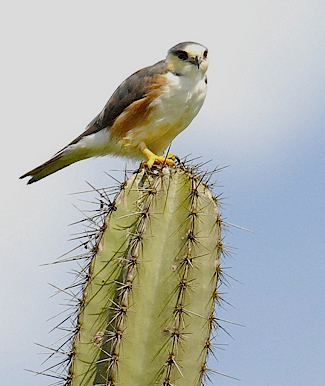
Among the
smallest of the New World raptors, the dainty Pearl Kite
is nonetheless a fierce little predator. Lizards beware!
(Photo by tour participant Brian Stech)
COCOI HERON (Ardea cocoi)
GREAT EGRET
(AMERICAN) (Ardea alba
egretta)
SNOWY EGRET
(Egretta thula thula)
LITTLE BLUE HERON
(Egretta caerulea)
CATTLE EGRET
(IBIS) (Bubulcus ibis ibis)
STRIATED HERON
(SOUTH AMERICAN) (Butorides
striata striata)
BLACK-CROWNED
NIGHT-HERON (AMERICAN) (Nycticorax
nycticorax hoactli)
YELLOW-CROWNED
NIGHT-HERON (Nyctanassa
violacea)
Threskiornithidae (Ibises and Spoonbills)
WHITE IBIS (Eudocimus
albus)
ROSEATE SPOONBILL
(Platalea ajaja)
Cathartidae (New World Vultures)
BLACK VULTURE (Coragyps atratus)
TURKEY VULTURE
(Cathartes aura)
Accipitridae (Hawks, Eagles, and Kites)
HOOK-BILLED KITE (Chondrohierax uncinatus)
SWALLOW-TAILED
KITE (Elanoides forficatus)
PEARL KITE
(Gampsonyx swainsonii magnus)
WHITE-TAILED KITE
(Elanus leucurus)
SNAIL KITE
(Rostrhamus sociabilis sociabilis)
PLUMBEOUS KITE
(Ictinia plumbea)
BLACK-CHESTED
BUZZARD-EAGLE (Geranoaetus
melanoleucus australis)
SHARP-SHINNED HAWK
(PLAIN-BREASTED) (Accipiter
striatus ventralis)
BICOLORED HAWK
(BICOLORED) (Accipiter bicolor
bicolor)
CRANE HAWK
(BLACKISH) (Geranospiza
caerulescens balzarensis)
BARRED HAWK
(Leucopternis princeps)
GRAY-BACKED HAWK
(Leucopternis occidentalis)
GREAT BLACK-HAWK
(Buteogallus urubitinga urubitinga)
SAVANNA HAWK
(Buteogallus meridionalis)
HARRIS'S HAWK
(HARRIS'S) (Parabuteo
unicinctus harrisi)
ROADSIDE HAWK
(Buteo magnirostris)
BROAD-WINGED HAWK
(NORTHERN) (Buteo platypterus
platypterus) [b]
GRAY HAWK (Buteo nitidus)
VARIABLE HAWK
(Buteo polyosoma)
Falconidae (Falcons and Caracaras)
CARUNCULATED CARACARA (Phalcoboenus carunculatus)
CRESTED CARACARA
(Caracara cheriway cheriway)
LAUGHING FALCON
(Herpetotheres cachinnans)
AMERICAN KESTREL
(COLOMBIAN) (Falco sparverius
peruvianus)
BAT FALCON
(Falco rufigularis)
PEREGRINE FALCON
(Falco peregrinus)
Rallidae (Rails, Gallinules, and Coots)
RUFOUS-NECKED WOOD-RAIL (Aramides axillaris) [*]
PLUMBEOUS RAIL
(Pardirallus sanguinolentus) [*]
PURPLE GALLINULE
(Porphyrio martinica)
Aramidae (Limpkin)
LIMPKIN (Aramus
guarauna guarauna)
Charadriidae (Plovers and Lapwings)
COLLARED PLOVER (Charadrius collaris)
KILLDEER (Charadrius vociferus peruvianus)
Recurvirostridae (Stilts and Avocets)
BLACK-NECKED STILT (BLACK-NECKED)
(Himantopus mexicanus mexicanus)
Jacanidae (Jacanas)
WATTLED JACANA (Jacana jacana scapularis)
Scolopacidae (Sandpipers and Allies)
SPOTTED SANDPIPER (Actitis macularius) [b]
SOLITARY SANDPIPER
(Tringa solitaria) [b]
WILLET (Tringa semipalmata) [b]
WHIMBREL (Numenius phaeopus) [b]
Laridae (Gulls, Terns, and Skimmers)
LAUGHING GULL (Leucophaeus atricilla) [b]
FRANKLIN'S GULL
(Leucophaeus pipixcan) [b]
GULL-BILLED TERN
(Gelochelidon nilotica)
Columbidae (Pigeons and Doves)
ROCK PIGEON (Columba livia) [I]
PALE-VENTED PIGEON
(Patagioenas cayennensis)
BAND-TAILED PIGEON
(WHITE-NECKED) (Patagioenas
fasciata albilinea)
PLUMBEOUS PIGEON
(Patagioenas plumbea chapmani)
RUDDY PIGEON
(BERLEPSCH'S) (Patagioenas
subvinacea berlepschi)
[*]
EARED DOVE
(Zenaida auriculata hypoleuca)
ECUADORIAN
GROUND-DOVE (Columbina
buckleyi)
CROAKING
GROUND-DOVE (Columbina
cruziana)
BLUE GROUND-DOVE
(Claravis pretiosa)
WHITE-TIPPED DOVE
(DECOLOR) (Leptotila verreauxi
decolor)
WHITE-THROATED
QUAIL-DOVE (Geotrygon frenata)
Psittacidae (Parrots)
GOLDEN-PLUMED PARAKEET (Leptosittaca branickii)
EL ORO PARAKEET
(Pyrrhura orcesi)
WHITE-NECKED
PARAKEET (Pyrrhura albipectus)
RED-MASKED
PARAKEET (Aratinga
erythrogenys)
PACIFIC PARROTLET
(Forpus coelestis)
GRAY-CHEEKED
PARAKEET (Brotogeris
pyrrhoptera)
RED-FACED PARROT
(Hapalopsittaca pyrrhops)
RED-BILLED PARROT
(Pionus sordidus corallinus)
BRONZE-WINGED
PARROT (Pionus chalcopterus)
RED-LORED PARROT
(SALVIN'S) (Amazona autumnalis
lilacina)
SCALY-NAPED PARROT
(Amazona mercenaria)
Cuculidae (Cuckoos)
LITTLE CUCKOO (Coccycua minuta gracilis)
SQUIRREL CUCKOO
(NIGRICRISSA) (Piaya cayana
nigricrissa) [*]
STRIPED CUCKOO
(Tapera naevia naevia) [*]
SMOOTH-BILLED ANI
(Crotophaga ani)
GROOVE-BILLED ANI
(Crotophaga sulcirostris)
Tytonidae (Barn-Owls)
BARN OWL (AMERICAN) (Tyto alba contempta)
Strigidae (Owls)
PERUVIAN SCREECH-OWL (Megascops roboratus pacificus)
[*]
SPECTACLED OWL
(Pulsatrix perspicillata chapmani)
[*]
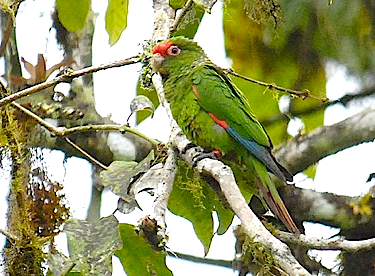
This tour
features a number of rare and/or local parrot species,
including the very local El Oro Parakeet, endemic to a
narrow belt of montane forest in SW Ecuador. (Photo by
tour participant Brian Stech)
GREAT HORNED OWL (Bubo virginianus)
ANDEAN PYGMY-OWL
(Glaucidium jardinii)
PERUVIAN PYGMY-OWL
(Glaucidium peruanum)
BLACK-AND-WHITE
OWL (Ciccaba nigrolineata)
Caprimulgidae (Nightjars and Allies)
COMMON PAURAQUE (Nyctidromus albicollis) [N]
Apodidae (Swifts)
CHESTNUT-COLLARED SWIFT (Streptoprocne rutila brunnitorques)
WHITE-COLLARED
SWIFT (Streptoprocne zonaris)
SHORT-TAILED SWIFT
(TUMBES) (Chaetura brachyura
ocypetes)
GRAY-RUMPED SWIFT
(ASH-RUMPED) (Chaetura
cinereiventris occidentalis)
LESSER
SWALLOW-TAILED SWIFT (Panyptila
cayennensis)
Trochilidae (Hummingbirds)
WHITE-NECKED JACOBIN (Florisuga mellivora)
BAND-TAILED
BARBTHROAT (Threnetes ruckeri)
WHITE-WHISKERED
HERMIT (Phaethornis yaruqui)
LONG-BILLED HERMIT
(BARON'S) (Phaethornis
longirostris baroni)
WEDGE-BILLED
HUMMINGBIRD (Schistes
geoffroyi albogularis)
BROWN VIOLETEAR
(Colibri delphinae)
SPARKLING
VIOLETEAR (Colibri coruscans
coruscans)
PURPLE-CROWNED
FAIRY (Heliothryx barroti)
AMETHYST-THROATED
SUNANGEL (AMETHYST-THROATED) (Heliangelus
amethysticollis laticlavius)
LITTLE SUNANGEL
(Heliangelus micraster)
PURPLE-THROATED
SUNANGEL (Heliangelus viola)
GREEN THORNTAIL
(Discosura conversii)
SPECKLED
HUMMINGBIRD (Adelomyia
melanogenys maculata)
LONG-TAILED SYLPH
(Aglaiocercus kingi mocoa)
VIOLET-TAILED
SYLPH (Aglaiocercus coelestis
aethereus)
RUFOUS-CAPPED
THORNBILL (Chalcostigma
ruficeps)
RAINBOW-BEARDED
THORNBILL (Chalcostigma
herrani)
TYRIAN METALTAIL
(Metallura tyrianthina tyrianthina)
GLOWING PUFFLEG
(Eriocnemis vestita smaragdinipectus)
SHINING SUNBEAM
(Aglaeactis cupripennis)
BRONZY INCA
(Coeligena coeligena)
BROWN INCA
(Coeligena wilsoni)
COLLARED INCA
(COLLARED) (Coeligena torquata
fulgidigula)
BUFF-WINGED
STARFRONTLET (Coeligena
lutetiae)
RAINBOW
STARFRONTLET (Coeligena iris
iris)
MOUNTAIN
VELVETBREAST (Lafresnaya
lafresnayi saul)
CHESTNUT-BREASTED
CORONET (Boissonneaua
matthewsii)
FAWN-BREASTED
BRILLIANT (Heliodoxa
rubinoides aequatorialis)
GREEN-CROWNED
BRILLIANT (Heliodoxa jacula
jamesoni)
GIANT HUMMINGBIRD
(Patagona gigas peruviana)
LONG-BILLED
STARTHROAT (Heliomaster
longirostris albicrissa)
PURPLE-COLLARED
WOODSTAR (Myrtis fanny fanny)
WHITE-BELLIED
WOODSTAR (Chaetocercus
mulsant)
LITTLE WOODSTAR
(Chaetocercus bombus)
GREEN-CROWNED
WOODNYMPH (EMERALD-BELLIED) (Thalurania
fannyi hypochlora)
AMAZILIA
HUMMINGBIRD (AMAZILIA) (Amazilia
amazilia dumerilii)
AMAZILIA
HUMMINGBIRD (LOJA) (Amazilia
amazilia alticola)
ANDEAN EMERALD
(Amazilia franciae)
RUFOUS-TAILED
HUMMINGBIRD (Amazilia tzacatl)
VIOLET-BELLIED
HUMMINGBIRD (Damophila julie)
Trogonidae (Trogons)
GOLDEN-HEADED QUETZAL (Pharomachrus auriceps auriceps)
ECUADORIAN TROGON
(Trogon mesurus)
GARTERED TROGON
(Trogon caligatus)
COLLARED TROGON
(COLLARED) (Trogon collaris
virginalis)
MASKED TROGON
(Trogon personatus temperatus)
Momotidae (Motmots)
WHOOPING MOTMOT (ARGENTICINCTUS)
(Momotus subrufescens argenticinctus)
RUFOUS MOTMOT
(Baryphthengus martii)
Alcedinidae (Kingfishers)
RINGED KINGFISHER (Megaceryle torquata)
Bucconidae (Puffbirds)
BARRED PUFFBIRD (Nystalus radiatus)
WHITE-WHISKERED
PUFFBIRD (Malacoptila
panamensis)
Capitonidae (New World Barbets)
RED-HEADED BARBET (Eubucco bourcierii)
Ramphastidae (Toucans)
EMERALD TOUCANET (BLACK-THROATED)
(Aulacorhynchus prasinus cyanolaemus)
GRAY-BREASTED
MOUNTAIN-TOUCAN (Andigena
hypoglauca lateralis)
COLLARED ARACARI
(STRIPE-BILLED) (Pteroglossus
torquatus erythropygius)
BLACK-MANDIBLED
TOUCAN (CHESTNUT-MANDIBLED) (Ramphastos
ambiguus swainsonii)
CHOCO TOUCAN
(Ramphastos brevis)
Picidae (Woodpeckers)
ECUADORIAN PICULET (Picumnus sclateri)
OLIVACEOUS PICULET
(Picumnus olivaceus)
SMOKY-BROWN
WOODPECKER (Picoides
fumigatus)
SCARLET-BACKED
WOODPECKER (Veniliornis
callonotus)
GOLDEN-OLIVE
WOODPECKER (RUBRIPILEUS) (Colaptes
rubiginosus rubripileus)
CRIMSON-MANTLED
WOODPECKER (Colaptes rivolii
brevirostris)
GUAYAQUIL
WOODPECKER (Campephilus
gayaquilensis)
Furnariidae (Ovenbirds and Woodcreepers)
TAWNY-THROATED LEAFTOSSER (Sclerurus mexicanus)
PALE-LEGGED
HORNERO (PACIFIC) (Furnarius
leucopus cinnamomeus)
AZARA'S SPINETAIL
(Synallaxis azarae ochracea)
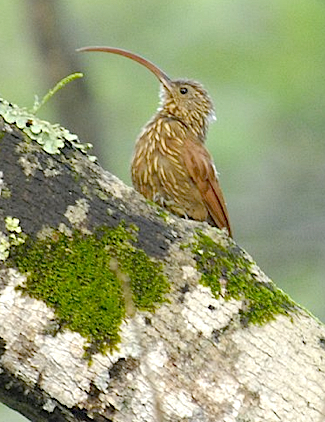
It may be a
widespread species in Ecuador, but a Red-billed Scythebill
is always a spectacular sight, even more enjoyable when
seen from the dinner table! (Photo by tour participant
Brian Stech)
RUFOUS SPINETAIL (Synallaxis unirufa unirufa) [*]
SLATY SPINETAIL
(Synallaxis brachyura) [*]
BLACKISH-HEADED
SPINETAIL (Synallaxis tithys)
WHITE-BROWED
SPINETAIL (Hellmayrea gularis
gularis)
LINE-CHEEKED
SPINETAIL (Cranioleuca
antisiensis antisiensis)
MOUSE-COLORED
THISTLETAIL (Asthenes
griseomurina)
RUFOUS-FRONTED
THORNBIRD (Phacellodomus
rufifrons)
SPOTTED BARBTAIL
(Premnoplex brunnescens)
PEARLED TREERUNNER
(Margarornis squamiger perlatus)
STREAKED
TUFTEDCHEEK (Pseudocolaptes
boissonneautii orientalis)
SCALY-THROATED
FOLIAGE-GLEANER (SPOT-BREASTED) (Anabacerthia variegaticeps temporalis)
MONTANE
FOLIAGE-GLEANER (Anabacerthia
striaticollis) [*]
BUFF-BROWED
FOLIAGE-GLEANER (Syndactyla
rufosuperciliata)
RUFOUS-NECKED
FOLIAGE-GLEANER (Syndactyla
ruficollis)
STRIPED
WOODHAUNTER (CENTRAL AMERICAN) (Hyloctistes
subulatus virgatus)
HENNA-HOODED
FOLIAGE-GLEANER (Hylocryptus
erythrocephalus)
STREAKED XENOPS
(Xenops rutilans guayae)
PLAIN-BROWN
WOODCREEPER (PLAIN-BROWN) (Dendrocincla
fuliginosa ridgwayi)
OLIVACEOUS
WOODCREEPER (PACIFIC) (Sittasomus
griseicapillus aequatorialis)
WEDGE-BILLED
WOODCREEPER (Glyphorynchus
spirurus pectoralis)
SPOTTED
WOODCREEPER (BERLEPSCH'S) (Xiphorhynchus
erythropygius aequatorialis)
STREAK-HEADED
WOODCREEPER (Lepidocolaptes
souleyetii)
MONTANE
WOODCREEPER (Lepidocolaptes
lacrymiger aequatorialis)
RED-BILLED
SCYTHEBILL (Campylorhamphus
trochilirostris thoracicus)
Thamnophilidae (Typical Antbirds)
GREAT ANTSHRIKE (Taraba major transandeanus)
CHAPMAN'S
ANTSHRIKE (Thamnophilus
zarumae zarumae)
COLLARED ANTSHRIKE
(Thamnophilus bernardi)
WESTERN
SLATY-ANTSHRIKE (Thamnophilus
atrinucha atrinucha)
UNIFORM ANTSHRIKE
(Thamnophilus unicolor unicolor)
RUSSET ANTSHRIKE
(TAWNY) (Thamnistes anabatinus
intermedius)
PLAIN ANTVIREO
(Dysithamnus mentalis aequatorialis)
CHECKER-THROATED
ANTWREN (Epinecrophylla
fulviventris) [*]
SLATY ANTWREN
(Myrmotherula schisticolor schisticolor)
CHESTNUT-BACKED
ANTBIRD (Myrmeciza exsul)
IMMACULATE ANTBIRD
(Myrmeciza immaculata macrorhyncha)
Grallariidae (Antpittas)
SCALED ANTPITTA (Grallaria guatimalensis regulus) [*]
CHESTNUT-CROWNED
ANTPITTA (Grallaria
ruficapilla connectens)
[*]
WATKINS'S ANTPITTA
(Grallaria watkinsi)
JOCOTOCO ANTPITTA
(Grallaria ridgelyi)
CHESTNUT-NAPED
ANTPITTA (Grallaria nuchalis
nuchalis)
RUFOUS ANTPITTA
(Grallaria rufula rufula)
SLATE-CROWNED
ANTPITTA (SLATE-CROWNED) (Grallaricula
nana nana) [*]
CRESCENT-FACED
ANTPITTA (Grallaricula
lineifrons)
Rhinocryptidae (Tapaculos)
OCELLATED TAPACULO (Acropternis orthonyx infuscatus) [*]
ASH-COLORED
TAPACULO (Myornis senilis)
BLACKISH TAPACULO
(PACIFIC) (Scytalopus latrans
subcinereus) [*]
LONG-TAILED
TAPACULO (Scytalopus
micropterus) [*]
ECUADORIAN
TAPACULO (Scytalopus robbinsi)
CHUSQUEA TAPACULO
(Scytalopus parkeri)
Melanopareiidae (Crescentchests)
ELEGANT CRESCENTCHEST (Melanopareia elegans elegans)
Tyrannidae (Tyrant Flycatchers)
SOUTHERN BEARDLESS-TYRANNULET (SOUTHERN)
(Camptostoma obsoletum sclateri)
WHITE-BANDED
TYRANNULET (Mecocerculus
stictopterus stictopterus)
WHITE-THROATED
TYRANNULET (Mecocerculus
leucophrys rufomarginatis)
TUFTED TIT-TYRANT
(Anairetes parulus)
MOUSE-COLORED
TYRANNULET (TUMBES) (Phaeomyias
murina tumbezana)
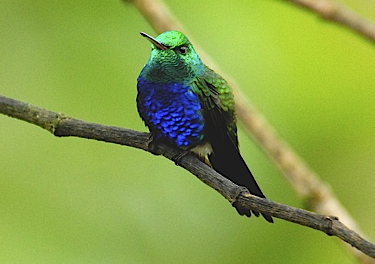
With nearly 40
species of hummingbirds seen on the tour, it's a bit tough
to choose a favorite, but the sparkling little
Violet-bellied Hummingbird has got to be a contender!
(Photo by tour participant Brian Stech)
PACIFIC ELAENIA (Myiopagis subplacens)
GREENISH ELAENIA
(GREENISH) (Myiopagis
viridicata implacens)
YELLOW-BELLIED
ELAENIA (Elaenia flavogaster
semipagana)
WHITE-CRESTED
ELAENIA (WHITE-CRESTED) (Elaenia
albiceps griseigularis)
HIGHLAND ELAENIA
(Elaenia obscura)
SIERRAN ELAENIA
(ANDEAN) (Elaenia pallatangae
pallatangae)
OLIVE-STRIPED
FLYCATCHER (Mionectes
olivaceus hederaceus)
OCHRE-BELLIED
FLYCATCHER (Mionectes
oleagineus)
SLATY-CAPPED
FLYCATCHER (Leptopogon
superciliaris)
VARIEGATED
BRISTLE-TYRANT (Phylloscartes
poecilotis)
SOOTY-HEADED
TYRANNULET (Phyllomyias
griseiceps)
BLACK-CAPPED
TYRANNULET (Phyllomyias
nigrocapillus nigrocapillus)
GOLDEN-FACED
TYRANNULET (LOJA) (Zimmerius
chrysops flavidifrons)
ORNATE FLYCATCHER
(Myiotriccus ornatus stellatus)
BRONZE-OLIVE
PYGMY-TYRANT (Pseudotriccus
pelzelni annectens) [*]
RUFOUS-HEADED
PYGMY-TYRANT (Pseudotriccus
ruficeps) [*]
TAWNY-CROWNED
PYGMY-TYRANT (Euscarthmus
meloryphus fulviceps)
SCALE-CRESTED
PYGMY-TYRANT (Lophotriccus
pileatus squamaecrista)
BLACK-THROATED
TODY-TYRANT (Hemitriccus
granadensis pyrrhops)
COMMON
TODY-FLYCATCHER (Todirostrum
cinereum sclateri)
YELLOW-OLIVE
FLYCATCHER (EQUATORIAL) (Tolmomyias
sulphurescens aequatorialis)
WHITE-THROATED
SPADEBILL (Platyrinchus
mystaceus albogularis)
CINNAMON
FLYCATCHER (Pyrrhomyias
cinnamomeus pyrrhopterus)
ORANGE-BANDED
FLYCATCHER (Nephelomyias
lintoni)
SULPHUR-RUMPED
FLYCATCHER (Myiobius
sulphureipygius aureatus)
BRAN-COLORED
FLYCATCHER (BRAN-COLORED) (Myiophobus
fasciatus crypterythrus)
GRAY-BREASTED
FLYCATCHER (Lathrotriccus
griseipectus)
SMOKE-COLORED
PEWEE (Contopus fumigatus
zarumae)
TROPICAL PEWEE
(TUMBES) (Contopus cinereus
punensis)
BLACK PHOEBE
(WHITE-WINGED) (Sayornis
nigricans angustirostris)
VERMILION
FLYCATCHER (VERMILION) (Pyrocephalus
rubinus piurae)
RUFOUS-TAILED
TYRANT (Knipolegus poecilurus)
BLACK-BILLED
SHRIKE-TYRANT (Agriornis
montanus solitarius)
WHITE-TAILED
SHRIKE-TYRANT (Agriornis
albicauda)
STREAK-THROATED
BUSH-TYRANT (Myiotheretes
striaticollis striaticollis)
MASKED
WATER-TYRANT (Fluvicola
nengeta atripennis)
YELLOW-BELLIED
CHAT-TYRANT (Ochthoeca diadema
gratiosa) [*]
RUFOUS-BREASTED
CHAT-TYRANT (Ochthoeca
rufipectoralis obfuscata)
BROWN-BACKED
CHAT-TYRANT (Ochthoeca
fumicolor brunneifrons)
LONG-TAILED TYRANT
(Colonia colonus)
DUSKY-CAPPED
FLYCATCHER (Myiarchus
tuberculifer nigriceps)
SOOTY-CROWNED
FLYCATCHER (Myiarchus
phaeocephalus phaeocephalus)
PALE-EDGED
FLYCATCHER (Myiarchus
cephalotes)
BOAT-BILLED
FLYCATCHER (TUMBES) (Megarynchus
pitangua chrysogaster)
SOCIAL FLYCATCHER
(TUMBES) (Myiozetetes similis
grandis)
GOLDEN-CROWNED
FLYCATCHER (Myiodynastes
chrysocephalus minor)
BAIRD'S FLYCATCHER
(Myiodynastes bairdii)
STREAKED
FLYCATCHER (STREAKED) (Myiodynastes
maculatus chapmani)
PIRATIC FLYCATCHER
(Legatus leucophaius)
SNOWY-THROATED
KINGBIRD (Tyrannus
niveigularis)
TROPICAL KINGBIRD
(Tyrannus melancholicus melancholicus)
Cotingidae (Cotingas)
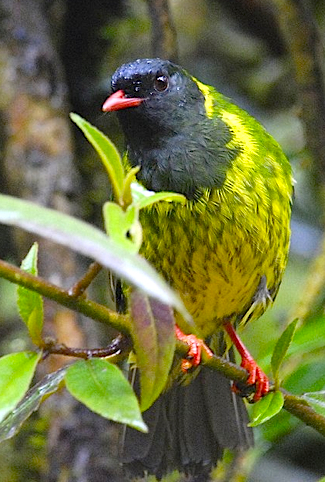
A handsome male
Green-and-black Fruiteater peers out from the canopy of a
fruiting tree. (Photo by tour participant Brian Stech)
GREEN-AND-BLACK FRUITEATER
(GREEN-AND-BLACK) (Pipreola
riefferii occidentalis)
BARRED FRUITEATER
(Pipreola arcuata arcuata) [*]
SCALED FRUITEATER
(Ampelioides tschudii)
CHESTNUT-CRESTED
COTINGA (Ampelion rufaxilla)
LONG-WATTLED
UMBRELLABIRD (Cephalopterus
penduliger)
Pipridae (Manakins)
GOLDEN-WINGED MANAKIN (Masius chrysopterus coronulatus) [*]
CLUB-WINGED
MANAKIN (Machaeropterus
deliciosus)
WHITE-BEARDED
MANAKIN (Manacus manacus)
Tityridae (Tityras and Allies)
MASKED TITYRA (Tityra semifasciata nigriceps)
BARRED BECARD
(Pachyramphus versicolor versicolor)
SLATY BECARD
(Pachyramphus spodiurus)
BLACK-AND-WHITE
BECARD (Pachyramphus
albogriseus guayaquilensis)
ONE-COLORED BECARD
(Pachyramphus homochrous homochrous)
Vireonidae (Vireos)
BROWN-CAPPED VIREO (Vireo leucophrys josephae)
RED-EYED VIREO
(RESIDENT CHIVI) (Vireo
olivaceus griseobarbatus)
LESSER GREENLET
(GRAY-HEADED) (Hylophilus
decurtatus minor)
RUFOUS-BROWED
PEPPERSHRIKE (YELLOW-BACKED) (Cyclarhis
gujanensis virenticeps)
Corvidae (Crows, Jays, and Magpies)
TURQUOISE JAY (Cyanolyca turcosa)
WHITE-TAILED JAY
(Cyanocorax mystacalis)
Hirundinidae (Swallows)
BLUE-AND-WHITE SWALLOW (CYANOLEUCA)
(Pygochelidon cyanoleuca cyanoleuca)
PALE-FOOTED
SWALLOW (Orochelidon flavipes)
BROWN-BELLIED
SWALLOW (Orochelidon murina)
SOUTHERN
ROUGH-WINGED SWALLOW (Stelgidopteryx
ruficollis uropygialis)
GRAY-BREASTED
MARTIN (Progne chalybea
chalybea)
BROWN-CHESTED
MARTIN (Progne tapera)
BARN SWALLOW
(AMERICAN) (Hirundo rustica
erythrogaster) [b]
CHESTNUT-COLLARED
SWALLOW (Petrochelidon
rufocollaris aequatorialis)
Troglodytidae (Wrens)
FASCIATED WREN (Campylorhynchus fasciatus pallescens)
RUFOUS WREN
(Cinnycerthia unirufa unibrunnea)
PLAIN-TAILED WREN
(Pheugopedius euophrys)
WHISKERED WREN
(Pheugopedius mystacalis mystacalis)
SPECKLE-BREASTED
WREN (SPECKLE-BREASTED) (Pheugopedius
sclateri paucimaculatus)
BAY WREN (SOUTH
AMERICAN) (Cantorchilus
nigricapillus nigricapillus)
SUPERCILIATED WREN
(Cantorchilus superciliaris)
HOUSE WREN
(SOUTHERN) (Troglodytes aedon
albicans)
MOUNTAIN WREN
(Troglodytes solstitialis solstitialis)
GRAY-BREASTED
WOOD-WREN (Henicorhina
leucophrys hilaris)
SONG WREN (Cyphorhinus phaeocephalus phaeocephalus)
[*]
Polioptilidae (Gnatcatchers)
TROPICAL GNATCATCHER (WHITE-BROWED)
(Polioptila plumbea bilineata)
Turdidae (Thrushes and Allies)
ANDEAN SOLITAIRE (Myadestes ralloides) [*]
SLATY-BACKED
NIGHTINGALE-THRUSH (SLATY-BACKED) (Catharus fuscater fuscater) [*]
SPOTTED
NIGHTINGALE-THRUSH (Catharus
dryas)
PALE-EYED THRUSH
(Turdus leucops)
PLUMBEOUS-BACKED
THRUSH (Turdus reevei)
ECUADORIAN THRUSH
(Turdus maculirostris)
MARANON THRUSH
(Turdus maranonicus)
GREAT THRUSH
(Turdus fuscater gigantodes)
CHIGUANCO THRUSH
(Turdus chiguanco chiguanco) [*]
GLOSSY-BLACK
THRUSH (Turdus serranus
fuscobrunneus)
Mimidae (Mockingbirds and Thrashers)
LONG-TAILED MOCKINGBIRD (Mimus longicaudatus)
Parulidae (New World Warblers)
MASKED YELLOWTHROAT (BLACK-LORED)
(Geothlypis aequinoctialis auricularis)
OLIVE-CROWNED
YELLOWTHROAT (Geothlypis
semiflava semiflava)
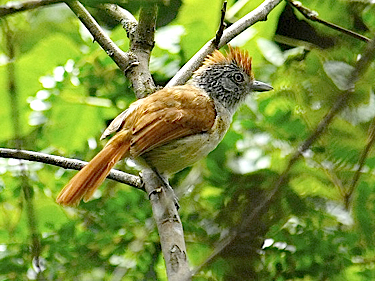
A specialty of
the Tumbes region, the Chapman's Antshrike is closely
allied with the widespread and familiar Barred Antshrike,
with which it was once considered conspecific. This is a
female. (Photo by tour participant Brian Stech)
TROPICAL PARULA (Setophaga pitiayumi pacifica)
BLACKBURNIAN
WARBLER (Setophaga fusca)
[b]
THREE-STRIPED
WARBLER (Basileuterus
tristriatus)
THREE-BANDED
WARBLER (Basileuterus
trifasciatus nitidior)
CITRINE WARBLER
(Myiothlypis luteoviridis luteoviridis)
BLACK-CRESTED
WARBLER (Myiothlypis
nigrocristatus)
BUFF-RUMPED
WARBLER (Myiothlypis
fulvicauda)
GRAY-AND-GOLD
WARBLER (Myiothlypis fraseri
ochraceicrista)
GRAY-AND-GOLD
WARBLER (Myiothlypis fraseri
fraseri)
RUSSET-CROWNED
WARBLER (Myiothlypis coronatus
castaneiceps)
SLATE-THROATED
REDSTART (Myioborus miniatus)
SPECTACLED
REDSTART (Myioborus
melanocephalus)
Coerebidae (Bananaquit)
BANANAQUIT (Coereba
flaveola intermedia)
Thraupidae (Tanagers and Allies)
BLACK-FACED TANAGER (Schistochlamys melanopis)
BLACK-CAPPED
HEMISPINGUS (BLACK-CAPPED) (Hemispingus
atropileus atropileus)
BLACK-HEADED
HEMISPINGUS (Hemispingus
verticalis)
GRAY-HOODED BUSH
TANAGER (RUBRIROSTRIS) (Cnemoscopus
rubrirostris rubrirostris)
RUFOUS-CHESTED
TANAGER (Thlypopsis ornata
media)
BLUE-BACKED
CONEBILL (Conirostrum
sitticolor sitticolor)
WHITE-SHOULDERED
TANAGER (Tachyphonus luctuosus
panamensis)
SILVER-BEAKED
TANAGER (Ramphocelus carbo
carbo)
FLAME-RUMPED
TANAGER (LEMON-RUMPED) (Ramphocelus
flammigerus icteronotus)
BLUE-GRAY TANAGER
(Thraupis episcopus quaesita)
PALM TANAGER
(Thraupis palmarum)
BLUE-CAPPED
TANAGER (Thraupis
cyanocephala)
HOODED
MOUNTAIN-TANAGER (Buthraupis
montana cucullata)
LACRIMOSE
MOUNTAIN-TANAGER (Anisognathus
lacrymosus caerulescens)
SCARLET-BELLIED
MOUNTAIN-TANAGER (Anisognathus
igniventris erythronotus)
GRASS-GREEN
TANAGER (Chlorornis riefferii
riefferii)
BUFF-BREASTED
MOUNTAIN-TANAGER (Dubusia
taeniata taeniata) [*]
GOLDEN-CROWNED
TANAGER (Iridosornis
rufivertex rufivertex)
FAWN-BREASTED
TANAGER (Pipraeidea melanonota
venezuelensis)
PARADISE TANAGER
(Tangara chilensis)
GOLDEN TANAGER
(Tangara arthus)
SILVER-THROATED
TANAGER (Tangara icterocephala
icterocephala)
FLAME-FACED
TANAGER (Tangara parzudakii)
RUFOUS-THROATED
TANAGER (Tangara rufigula)
BAY-HEADED TANAGER
(BAY-AND-BLUE) (Tangara gyrola
nupera)
GOLDEN-NAPED
TANAGER (Tangara ruficervix)
BLUE-NECKED
TANAGER (Tangara cyanicollis)
BLUE-AND-BLACK
TANAGER (Tangara vassorii
vassorii)
SILVERY TANAGER
(Tangara viridicollis fulvigula)
BLACK-FACED DACNIS
(Dacnis lineata)
GREEN HONEYCREEPER
(Chlorophanes spiza exsul)
SWALLOW TANAGER
(Tersina viridis)
STREAKED SALTATOR
(Saltator striatipectus flavidicollis)
STREAKED SALTATOR
(Saltator striatipectus peruvianus)
[*]
BLACK-COWLED
SALTATOR (Saltator nigriceps)
BUFF-THROATED
SALTATOR (Saltator maximus
maximus)
BLACK-WINGED
SALTATOR (Saltator atripennis)
Emberizidae (Buntings, Sparrows and
Allies)
ASH-BREASTED SIERRA-FINCH (Phrygilus plebejus ocularis)
BAND-TAILED
SIERRA-FINCH (Phrygilus
alaudinus)
BLUE-BLACK
GRASSQUIT (Volatinia jacarina
peruviensis)
VARIABLE SEEDEATER
(Sporophila corvina corvina)
BLACK-AND-WHITE
SEEDEATER (Sporophila
luctuosa)
YELLOW-BELLIED
SEEDEATER (Sporophila
nigricollis)
PARROT-BILLED
SEEDEATER (Sporophila
peruviana devronis)
DRAB SEEDEATER
(Sporophila simplex)
CHESTNUT-THROATED
SEEDEATER (Sporophila telasco)
THICK-BILLED
SEED-FINCH (Oryzoborus
funereus)
DULL-COLORED
GRASSQUIT (Tiaris obscurus
pauper)
GLOSSY
FLOWERPIERCER (Diglossa
lafresnayii)
WHITE-SIDED
FLOWERPIERCER (Diglossa
albilatera schistacea)
BLUISH
FLOWERPIERCER (Diglossa
caerulescens) [*]
MASKED
FLOWERPIERCER (Diglossa cyanea
dispar)
SAFFRON FINCH
(SAFFRON) (Sicalis flaveola
valida)
CRIMSON-BREASTED
FINCH (Rhodospingus cruentus)
ORANGE-BILLED
SPARROW (Arremon
aurantiirostris santarosae)
BLACK-CAPPED
SPARROW (Arremon abeillei
abeillei)
GRAY-BROWED
BRUSH-FINCH (Arremon assimilis
nigrifrons)
BLACK-STRIPED
SPARROW (Arremonops
conirostris striaticeps)
PALE-NAPED
BRUSH-FINCH (Atlapetes
pallidinucha papallactae)
TRICOLORED
BRUSH-FINCH (CHOCO) (Atlapetes
tricolor crassus)
YELLOW-BREASTED
BRUSH-FINCH (Atlapetes
latinuchus)
WHITE-WINGED
BRUSH-FINCH (WHITE-WINGED) (Atlapetes
leucopterus dresseri)
WHITE-HEADED
BRUSH-FINCH (Atlapetes
albiceps)
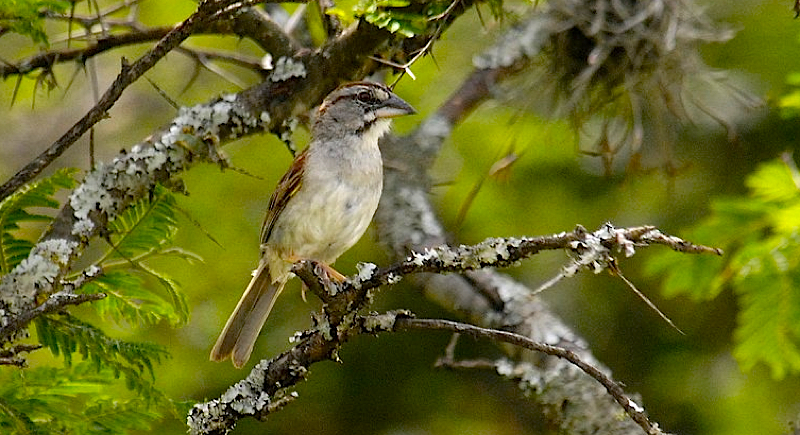
It might not be
the flashiest bird we saw, but the Tumbes Sparrow is one
of only 3 species named for the Tumbesian region (along
with Tumbes Hummingbird and Tyrant) and the only one of
the three to occur quite widely in Ecuador. (Photo by tour
participant Brian Stech)
PALE-HEADED BRUSH-FINCH (Atlapetes pallidiceps)
TUMBES SPARROW
(Rhynchospiza stolzmanni)
RUFOUS-COLLARED
SPARROW (Zonotrichia capensis)
COMMON
BUSH-TANAGER (NORTHERN ANDES) (Chlorospingus
ophthalmicus phaeocephalus)
SHORT-BILLED
BUSH-TANAGER (Chlorospingus
parvirostris)
YELLOW-THROATED
BUSH-TANAGER (YELLOW-THROATED) (Chlorospingus
flavigularis marginatus)
ASHY-THROATED
BUSH-TANAGER (ASHY-THROATED) (Chlorospingus
canigularis paulus)
Cardinalidae (Cardinals and Allies)
HEPATIC TANAGER (HIGHLAND) (Piranga flava lutea)
WHITE-WINGED
TANAGER (Piranga leucoptera
ardens) [*]
OCHRE-BREASTED
TANAGER (Chlorothraupis
stolzmanni)
GOLDEN-BELLIED
GROSBEAK (Pheucticus
chrysogaster chrysogaster)
BLUE SEEDEATER
(Amaurospiza concolor)
BLUE-BLACK
GROSBEAK (Cyanocompsa
cyanoides)
Icteridae (Troupials and Allies)
PERUVIAN MEADOWLARK (Sturnella bellicosa bellicosa)
SCRUB BLACKBIRD
(Dives warszewiczi warszewiczi)
GREAT-TAILED
GRACKLE (Quiscalus mexicanus)
SHINY COWBIRD
(Molothrus bonariensis)
WHITE-EDGED ORIOLE
(Icterus graceannae)
YELLOW-TAILED
ORIOLE (Icterus mesomelas
taczanowskii)
YELLOW-BILLED
CACIQUE (Amblycercus
holosericeus)
MOUNTAIN CACIQUE
(GOLDEN-SHOULDERED) (Cacicus
chrysonotus leucoramphus)
SCARLET-RUMPED
CACIQUE (PACIFIC) (Cacicus
uropygialis pacificus)
YELLOW-RUMPED
CACIQUE (WESTERN) (Cacicus
cela flavicrissus)
Fringillidae (Siskins, Crossbills, and
Allies)
ORANGE-CROWNED EUPHONIA (Euphonia saturata)
THICK-BILLED
EUPHONIA (THICK-BILLED) (Euphonia
laniirostris hypoxantha)
BRONZE-GREEN
EUPHONIA (Euphonia mesochrysa)
ORANGE-BELLIED
EUPHONIA (Euphonia
xanthogaster)
YELLOW-BELLIED
SISKIN (Spinus xanthogastrus
xanthogastrus)
HOODED SISKIN
(Spinus magellanicus)
SAFFRON SISKIN
(Spinus siemiradzkii)
OLIVACEOUS SISKIN
(Spinus olivaceus)
Passeridae (Old World Sparrows)
HOUSE SPARROW (Passer domesticus) [I]
MANTLED HOWLER
MONKEY (Alouatta palliata)
HOFFMANN'S
TWO-TOED SLOTH (Choloepus
hoffmanni)
RED-TAILED
SQUIRREL (Sciurus granatensis)
GUAYAQUIL SQUIRREL
(Sciurus stramineus)
CENTRAL AMERICAN
AGOUTI (Dasyprocta punctata)
SOUTH AMERICAN
COATI (Nasua nasua)
Totals for the tour: 440 bird taxa and 6 mammal taxa








